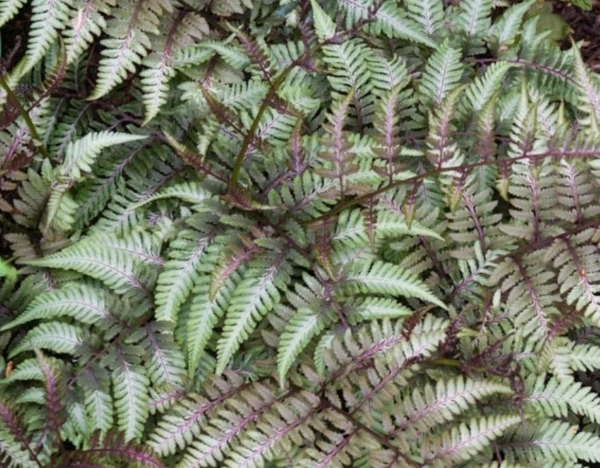
Japanese Painted Fern
Botanical Name
:
Athyrium niponicum var. pictum
Plant Type
:
Deciduous perennial, fern, ground cover
Seasons
:
Spring, summer, fall (dormant in winter)
Sun Level
:
Partial to full shade (Prefers morning sun with afternoon shade)
Ideal Soil Temperature for Planting
:
55–70°F (13–21°C)
Soil Type
:
Moist, well-draining, rich in organic matter.
Hardiness Zones
:
4-9
Germination
:
Typically propagated by division rather than seeds
P.H. Level
:
Slightly acidic to neutral (5.5–7.0)
Water/Irrigation
:
Prefers consistently moist soil, avoid letting soil dry out completely. Reduce watering during cooler months
Fertilization
:
Optional. If fertilizing, apply compost or a balanced slow-release fertilizer in early spring.
Habit
:
Low-growing, spreading, arching fronds
Final Plant Height
:
12–18 inches (30–45 cm)
Spread
:
18–24 inches (45–60 cm)
Spacing
:
18–24 inches apart to allow for natural spread.
Flowers
:
Non-flowering (grown for its ornamental foliage)
Attracts
:
Not known to attract pollinators, mainly used for foliage interest.
Uses
:
Shade gardens, woodland gardens, borders, containers, ground cover
Companions
:
Hostas, heucheras, astilbes, bleeding hearts, Japanese forest grass
Pruning
:
Remove old or damaged fronds in early spring for fresh growth.
Toxicity
:
Non-toxic to humans and pets
Pests
:
Can be susceptible to indoor pests like aphids, spider mites, and mealybugs if grown indoors. Outdoor pests are less common but may include slugs and snails.
Diseases
:
Resistant to most diseases but can develop root rot in poorly drained soil.
Did You Know?
The Japanese Painted Fern was recognized as the Perennial Plant of the Year in 2004 by the Perennial Plant Association (PPA) for its unique coloration and low maintenance.
Botanical Name
:
Athyrium niponicum var. pictum
Plant Type
:
Deciduous perennial, fern, ground cover
Seasons
:
Spring, summer, fall (dormant in winter)
Sun Level
:
Partial to full shade (Prefers morning sun with afternoon shade)
Ideal Soil Temperature for Planting
:
55–70°F (13–21°C)
Soil Type
:
Moist, well-draining, rich in organic matter.
Hardiness Zones
:
4-9
Germination
:
Typically propagated by division rather than seeds
P.H. Level
:
Slightly acidic to neutral (5.5–7.0)
Water/Irrigation
:
Prefers consistently moist soil, avoid letting soil dry out completely. Reduce watering during cooler months
Fertilization
:
Optional. If fertilizing, apply compost or a balanced slow-release fertilizer in early spring.
Habit
:
Low-growing, spreading, arching fronds
Final Plant Height
:
12–18 inches (30–45 cm)
Spread
:
18–24 inches (45–60 cm)
Spacing
:
18–24 inches apart to allow for natural spread.
Flowers
:
Non-flowering (grown for its ornamental foliage)
Attracts
:
Not known to attract pollinators, mainly used for foliage interest.
Uses
:
Shade gardens, woodland gardens, borders, containers, ground cover
Companions
:
Hostas, heucheras, astilbes, bleeding hearts, Japanese forest grass
Pruning
:
Remove old or damaged fronds in early spring for fresh growth.
Toxicity
:
Non-toxic to humans and pets
Pests
:
Can be susceptible to indoor pests like aphids, spider mites, and mealybugs if grown indoors. Outdoor pests are less common but may include slugs and snails.
Diseases
:
Resistant to most diseases but can develop root rot in poorly drained soil.
Did You Know?
The Japanese Painted Fern was recognized as the Perennial Plant of the Year in 2004 by the Perennial Plant Association (PPA) for its unique coloration and low maintenance.
Written by Salome Wapukha – https://www.linkedin.com/in/salome-wapukha-556700193/

